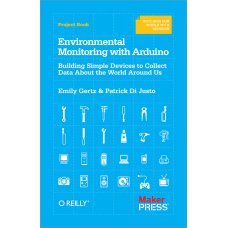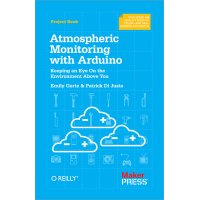After the devastating tsunami in 2011, DYIers in Japan built their own devices to detect radiation levels, then posted their finding on the Internet. Right now, thousands of people worldwide are tracking environmental conditions with monitoring devices they’ve built themselves. You can do it too!
This inspiring guide shows you how to use Arduino to create gadgets for measuring noise, weather, electromagnetic interference (EMI), water purity, and more. You’ll also learn how to collect and share your own data, and you can experiment by creating your own variations of the gadgets covered in the book. If you’re new to DIY electronics, the first chapter offers a primer on electronic circuits and Arduino programming.
- Use a special microphone and amplifier to build a reliable noise monitor
- Create a gadget to detect energy vampires: devices that use electricity when they’re “off”
- Examine water purity with a water conductivity device
- Measure weather basics such as temperature, humidity, and dew point
- Build your own Geiger counter to gauge background radiation
- Extend Arduino with an Ethernet shield—and put your data on the Internet
- Share your weather and radiation data online through Pachube
About the Authors
Emily Gertz is a correspondent for OnEarth Magazine. She has been covering DIY environmental monitoring since 2004, when she interviewed engineer-artist Natalie Jeremijenko for Worldchanging.com. Her latest, on citizen radiation monitoring in Japan, was published by OnEarth Magazine in April 2011. She has been hands-on with internet technologies since 1994 as a web producer, community host, and content strategist. Her articles have appeared in Grist, Dwell, Scientific American, Popular Mechanics, and more.
Patrick Di Justo is a contributing editor at Wired magazine, where he writes the magazine's monthly What's Inside column, and the author of The Science of Battlestar Galactica (Wiley, October 2010). His work has appeared in Dwell, Scientific American, Popular Science, The New York Times, and more. He has worked as a robot programmer for the Federal Reserve, and knows C, C++, Java, and Processing. He bought his first Arduino in 2007.
Chapter 1 The World’s Shortest Electronics Primer
- What Is Arduino?
- Electronic Circuits and Components
- Programming Arduino
- First Sketch: Make an LED Blink
Chapter 2 Project: Noise Monitor/LED Bar Output
- Measuring Noise: The Microphone
- Make the Gadget
Chapter 3 New Component: 4Char Display
- Test Project
Chapter 4 Detecting Electromagnetic Interference (and making bad music)
- Detecting EMI Sources in the Environment
- Make the Gadget
- What Are We Measuring with This Gadget?
Chapter 5 Project: Water Conductivity/Numerical Output
- What Is Conductivity, and Why Do I Care?
- Make the Gadget
Chapter 6 New Component: Ethernet Shield
- Using the Ethernet Shield
- Testing the Ethernet Shield
- Testing the SD Card Slot
- Things to Try
Chapter 7 Project: Humidity, Temperature & Dew Point/4Char Display
- You Don’t Have to Be a Weatherman to Measure the Weather
- Getting Usable Measurements
- First Electronic Sensor: The DHT-22
- Using Code Libraries
- Make the Gadget
Chapter 8 Real-Time, Geo-Tagged Data Sharing with Pachube
- Test Project: Connecting and Uploading Data to Pachube
- Things To Try
Chapter 9 Project: Radiation Counter/Sharing Data on the Internet
- What’s a Geiger Counter?
- Make the Gadget
- What Are We Measuring with This Gadget?
- Failure Mode Analysis
- Things to Try
Chapter 10 Casing the Gadget
Environmental Monitoring with Arduino
- Brand: Make:
- Product Code:Bok-Envrn-Mntr-Ard
- Reward Points:2
- Availability:In Stock
-
रo 175.00
- Price in reward points:175
Related Products
Atmospheric Monitoring with Arduino
Makers around the globe are building low-cost devices to monitor the environment, and with this hand..
रo 175.00
Tags: Environmental, Monitoring, Arduino, Book



